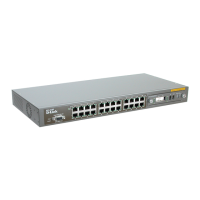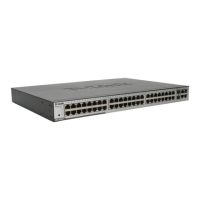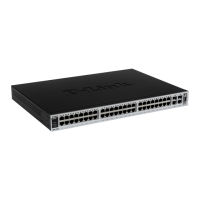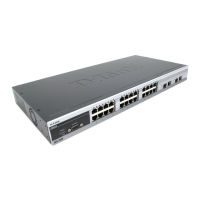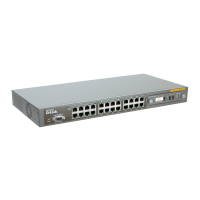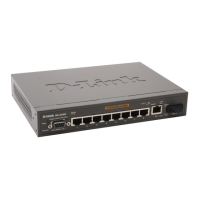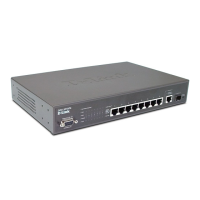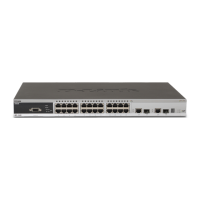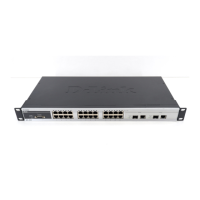Do you have a question about the D-Link DES-3350SR and is the answer not in the manual?
Describes the Switch and its features.
Basic installation, front/rear/side panels, and LED indicators.
How to connect the Switch to the Ethernet network.
How to connect to Ethernet/Fast Ethernet/Gigabit Ethernet networks.
Concepts and features for managing the switch.
Basic management features, password, SNMP, IP assignment.
Configuring basic functions, QoS, ACL, Port Mirroring, Spanning Tree.
SNMP, SSH details.
Layer 3 features like IP interface, OSPF, RIP, DHCP.
Features for monitoring switch and packet status.
Utility functions like TFTP, Ping Test, Save Changes.
Technical specifications of the Switch.
Detailed description of STP.
Guide for network managers familiar with concepts.
Explains NOTE, NOTICE, and CAUTION symbols.
Precautions to reduce risk of injury, shock, fire, and equipment damage.
Precautions for rack stability and safety.
Steps to prevent static damage to components.
IEEE 802.3 standard for 100Mbps data transmission.
Extension of IEEE 802.3 for tenfold throughput over 100Mbps.
Bridges Ethernet packets at MAC address level.
Key performance features like packet rates and buffer memory.
Classification based on 802.1P Priority, TCP/UDP, MAC addresses.
Compatibility with 802.1D and 802.1w Rapid Spanning Tree.
Support for 802.1Q and GARP/GVRP.
IGMP Snooping, DVMRP, PIM Dense mode support.
Features like Telnet Server, TFTP Client, DHCP Client.
Password, Web-based, SNMP, CLI support.
Support for RFC1213, RFC1493, RMON, etc.
4 Groups of RMON (Statistics, History, Alarms, Events).
Auto-Negotiation, Port Mirroring.
Static mode trunking, 802.3ad LACP.
RIP I/II, OSPF support, Floating static route.
802.1X Port/MAC based access control, Radius, SSH.
Filtering based on MAC address.
Contents of the shipping carton.
Guidelines for choosing an installation location.
Attaching rubber feet for desktop installation.
Mounting the switch in an EIA standard rack.
How to power on the switch and expected LED behavior.
Precautionary steps during a power failure.
Description of LEDs, RS-232 port, Ethernet and Gigabit ports.
Fans and AC power connector.
Heat vents for dissipation.
1000BASE-T copper and Mini-GBIC ports.
Explanation of Power, Console, and Link/Act LEDs.
Connecting PCs or routers to the switch.
Connecting to other network devices using cables.
LED indicators for 10BASE-T connections.
LED indicators for 100BASE-TX connections.
Out-of-band (console) or in-band (Telnet, Web) management.
Managing via browser like Netscape or IE.
Managing via SNMP v1, v2c, or v3.
Accessing the switch via RS-232 console port.
Equipment needed and connection steps.
Initial login process and access.
Setting up user accounts and passwords for security.
Alert messages for events like reboots or port status changes.
Management Information Base for storing counter data.
Setting the switch's IP address for management.
Managing the switch via browser from anywhere on the network.
Steps to access the switch via a web browser.
Adding and managing user accounts and privileges.
Two levels of user privileges: Admin and User.
Saving configuration changes to NV-RAM for permanence.
Describes the three distinct areas of the web interface.
Main folders in the web interface: Configuration, Management, etc.
Assigning an IP address for network management.
Viewing device type, MAC address, firmware version, etc.
Configuring settings like MAC address aging and IGMP snooping.
Naming individual ports for easier identification.
Setting port speed, duplex, and state (enabled/disabled).
Duplicating and forwarding traffic to a network analyzer.
Internet Group Management Protocol for multicast group membership.
Allowing the switch to read multicast group IP and MAC addresses.
Configuring ports as multicast router connections.
Compatibility with 802.1D and 802.1w Rapid Spanning Tree.
Implementing RSTP for faster convergence and compatibility.
Compares 802.1d and 802.1w port states.
Global STP settings like bridge max age and hello time.
Configuring STP parameters on a per-port basis.
Entering MAC addresses into the switch's forwarding table.
Statically entering multicast MAC addresses.
Support for IEEE 802.1Q VLANs and port untagging.
Support for IEEE 802.1Q VLANs and port untagging.
Terms like Tagging, Untagging, Ingress, Egress ports.
Packet forwarding decisions based on ingress, forwarding, and egress rules.
Adding, modifying, or deleting VLAN definitions.
Associating ports with VLANs for forwarding untagged packets.
Configuring ports to tag or untag 802.1Q VLAN packets.
Examining VLAN info in packet headers for forwarding decisions.
Initial configuration of VLAN 1 with all ports assigned.
Configuring GVRP, Ingress Checking, and Acceptable Frame Types.
Setting ingress and egress bandwidth limits for ports.
Enabling SNTP, setting primary/secondary servers and polling interval.
Enabling SNTP, setting primary/secondary servers and polling interval.
Changing time zone and Daylight Savings Time settings.
Locking dynamic MAC address learning on ports.
Locking dynamic MAC address learning on ports.
Configuring priority queuing and Class of Service.
Managing traffic control for broadcast, multicast, and unknown storms.
Assigning a default 802.1p priority to each port.
Assigning a Class of Traffic to 802.1p priorities.
Setting max packets and latency for queues.
Managing traffic segmentation on the switch.
Combining ports into a single high-bandwidth pipeline.
Combining ports into a single high-bandwidth pipeline.
Establishing criteria to determine packet forwarding.
Configuring Ethernet (MAC address) based access profiles.
Configuring IP address-based access profiles.
Configuring access rules based on packet header content.
Restricting access to authorized IP-MAC address pairs.
Enabling or disabling IP-MAC binding on specific ports.
Creating and managing IP-MAC binding entries.
Viewing devices blocked by IP-MAC binding restrictions.
Security measure for authorizing users via Client/Server model.
Security measure for authorizing users via Client/Server model.
Example configuration for port-based access control.
Example configuration for MAC-based access control.
Configuring 802.1x port settings and authenticator.
Configuring 802.1x port capabilities.
Initializing ports for port-based 802.1x authentication.
Initializing ports for MAC-based 802.1x authentication.
Reauthenticating ports for port-based 802.1x.
Reauthenticating ports for MAC-based 802.1x.
Centralized user administration and protection against hackers.
Allowing switch management from specific IP addresses.
Managing user accounts and their access rights.
Enabling secure remote login and network services.
Configuring SSH server settings like status and timeouts.
Configuring SSH algorithms for authentication and encryption.
Setting authentication methods (Host Based, Password, Public Key) for SSH users.
Support for SNMP versions 1, 2c, and 3 for monitoring.
Creating SNMP users and associating them with groups.
Assigning views to community strings to define MIB object access.
Mapping SNMP users to views for access control.
Defining SNMP community strings for manager access.
Setting up trap recipients for SNMP.
Unique identifier for SNMP V3 implementations.
Configuring IP interfaces for VLANs.
Enabling or disabling Layer 3 functions like DVMRP, PIM-DM, RIP.
Configuring MD5 keys for OSPF packet authentication.
Exchanging routing info between OSPF and RIP.
Entries into the switch's forwarding table using IP addresses.
Viewing, defining, and modifying ARP information.
Distance-vector routing protocol for network information exchange.
Configuring RIP settings for each IP interface.
Open Shortest Path First routing protocol.
Configuring OSPF settings per IP interface.
Configuring OSPF Area IDs as Normal or Stub.
Aggregating routing information into summary LSDB advertisements.
Sharing OSPF information with other OSPF routers.
Relaying DHCP/BOOTP information to the switch.
Setting up servers for relaying DHCP/BOOTP information.
Mapping domain names to IP addresses using DNS.
Translating text names to IP addresses using DNS.
How DNS servers resolve names to IP addresses.
Enabling/disabling DNS relay and cache status.
Configuring static DNS entries.
Protocols supporting IP multicasting.
Internet Group Management Protocol for multicast group membership.
Features of IGMP versions 1 and 2.
Configuring IGMP per IP interface.
Configuring DVMRP for each IP interface.
Protocol Independent Multicast - Dense Mode.
Configuring PIM-DM for each IP interface.
Displays the percentage of CPU being used.
Shows the percentage of total available bandwidth used on the port.
Viewing packet statistics as line graphs or tables.
Analyzing received packets (bytes, packets, unicast, multicast, broadcast).
Analyzing transmitted packets (bytes, packets).
Analyzing port error statistics (CRC, UnderSize, OverSize, etc.).
Categorizing packets by size.
Viewing packets received by size groups.
Viewing the switch's dynamic MAC address forwarding table.
Showing current ARP entries on the switch.
Viewing the switch's IGMP Snooping table.
Viewing the IGMP Snooping Forwarding Table.
Displaying information about the switch's current VLAN configuration.
Displaying which ports are configured as router ports.
Viewing the status of main and redundant power supplies.
Features for controlling access to switch ports.
Viewing authenticator status for PAE, Backend, and Port.
Features related to Layer 3 IP networking.
Viewing IP addresses discovered by the switch.
Shows the current IP routing table of the switch.
Showing current IP multicasting information on the switch.
Showing current IGMP group entries on the switch.
Monitoring OSPF information on the switch.
Link-state database in use by OSPF routing protocol.
Displays OSPF neighbors of the Switch.
Displays a list of Virtual OSPF Neighbors of the Switch.
Monitoring DVMRP information on the switch.
Stores multicast routing information gathered by DVMRP.
Contains information about DVMRP neighbors of the Switch.
Information regarding the next-hop for forwarding multicast packets.
Monitoring PIM information on the switch.
Contains information regarding each of a router's PIM neighbors.
Services for upgrading firmware, loading config files, and saving settings.
Updating the switch's firmware from a TFTP server.
Downloading configuration files from a TFTP server.
Uploading switch settings to a TFTP server.
Uploading the switch history log to a TFTP server.
Viewing the switch history log of traps and events.
Verifying connectivity between the switch and other nodes.
Saving configuration changes to NV-RAM for permanence.
Options to reboot, reset, reset system, or reset config.
Standards, protocols, data transfer rates, topology, cables, and ports.
AC input, power consumption, fans, operating/storage temperature, humidity.
Transmission method, RAM buffer, MAC address table size, packet rates.
Describes the behavior of a port in the blocking state.
Describes the behavior of a port in the listening state.
Describes the behavior of a port in the learning state.
Describes the behavior of a port in the forwarding state.
Describes the behavior of a disabled port.
General troubleshooting for Spanning Tree Protocol issues.
Common causes of STP failure like bridging loops.
Configuration error causing duplex mismatch issues.
Causes of unidirectional links and their impact on STP.
How packet corruption can lead to STP failures.
Issues related to CPU utilization and network diameter affecting STP.
Methods to identify and resolve data loops.
Describes the Switch and its features.
Basic installation, front/rear/side panels, and LED indicators.
How to connect the Switch to the Ethernet network.
How to connect to Ethernet/Fast Ethernet/Gigabit Ethernet networks.
Concepts and features for managing the switch.
Basic management features, password, SNMP, IP assignment.
Configuring basic functions, QoS, ACL, Port Mirroring, Spanning Tree.
SNMP, SSH details.
Layer 3 features like IP interface, OSPF, RIP, DHCP.
Features for monitoring switch and packet status.
Utility functions like TFTP, Ping Test, Save Changes.
Technical specifications of the Switch.
Detailed description of STP.
Guide for network managers familiar with concepts.
Explains NOTE, NOTICE, and CAUTION symbols.
Precautions to reduce risk of injury, shock, fire, and equipment damage.
Precautions for rack stability and safety.
Steps to prevent static damage to components.
IEEE 802.3 standard for 100Mbps data transmission.
Extension of IEEE 802.3 for tenfold throughput over 100Mbps.
Bridges Ethernet packets at MAC address level.
Key performance features like packet rates and buffer memory.
Classification based on 802.1P Priority, TCP/UDP, MAC addresses.
Compatibility with 802.1D and 802.1w Rapid Spanning Tree.
Support for 802.1Q and GARP/GVRP.
IGMP Snooping, DVMRP, PIM Dense mode support.
Features like Telnet Server, TFTP Client, DHCP Client.
Password, Web-based, SNMP, CLI support.
Support for RFC1213, RFC1493, RMON, etc.
4 Groups of RMON (Statistics, History, Alarms, Events).
Auto-Negotiation, Port Mirroring.
Static mode trunking, 802.3ad LACP.
RIP I/II, OSPF support, Floating static route.
802.1X Port/MAC based access control, Radius, SSH.
Filtering based on MAC address.
Contents of the shipping carton.
Guidelines for choosing an installation location.
Attaching rubber feet for desktop installation.
Mounting the switch in an EIA standard rack.
How to power on the switch and expected LED behavior.
Precautionary steps during a power failure.
Description of LEDs, RS-232 port, Ethernet and Gigabit ports.
Fans and AC power connector.
Heat vents for dissipation.
1000BASE-T copper and Mini-GBIC ports.
Explanation of Power, Console, and Link/Act LEDs.
Connecting PCs or routers to the switch.
Connecting to other network devices using cables.
LED indicators for 10BASE-T connections.
LED indicators for 100BASE-TX connections.
Out-of-band (console) or in-band (Telnet, Web) management.
Managing via browser like Netscape or IE.
Managing via SNMP v1, v2c, or v3.
Accessing the switch via RS-232 console port.
Equipment needed and connection steps.
Initial login process and access.
Setting up user accounts and passwords for security.
Alert messages for events like reboots or port status changes.
Management Information Base for storing counter data.
Setting the switch's IP address for management.
Managing the switch via browser from anywhere on the network.
Steps to access the switch via a web browser.
Adding and managing user accounts and privileges.
Two levels of user privileges: Admin and User.
Saving configuration changes to NV-RAM for permanence.
Describes the three distinct areas of the web interface.
Main folders in the web interface: Configuration, Management, etc.
Assigning an IP address for network management.
Viewing device type, MAC address, firmware version, etc.
Configuring settings like MAC address aging and IGMP snooping.
Naming individual ports for easier identification.
Setting port speed, duplex, and state (enabled/disabled).
Duplicating and forwarding traffic to a network analyzer.
Internet Group Management Protocol for multicast group membership.
Allowing the switch to read multicast group IP and MAC addresses.
Configuring ports as multicast router connections.
Compatibility with 802.1D and 802.1w Rapid Spanning Tree.
Implementing RSTP for faster convergence and compatibility.
Compares 802.1d and 802.1w port states.
Global STP settings like bridge max age and hello time.
Configuring STP parameters on a per-port basis.
Entering MAC addresses into the switch's forwarding table.
Statically entering multicast MAC addresses.
Support for IEEE 802.1Q VLANs and port untagging.
Support for IEEE 802.1Q VLANs and port untagging.
Terms like Tagging, Untagging, Ingress, Egress ports.
Packet forwarding decisions based on ingress, forwarding, and egress rules.
Adding, modifying, or deleting VLAN definitions.
Associating ports with VLANs for forwarding untagged packets.
Configuring ports to tag or untag 802.1Q VLAN packets.
Examining VLAN info in packet headers for forwarding decisions.
Initial configuration of VLAN 1 with all ports assigned.
Configuring GVRP, Ingress Checking, and Acceptable Frame Types.
Setting ingress and egress bandwidth limits for ports.
Enabling SNTP, setting primary/secondary servers and polling interval.
Enabling SNTP, setting primary/secondary servers and polling interval.
Changing time zone and Daylight Savings Time settings.
Locking dynamic MAC address learning on ports.
Locking dynamic MAC address learning on ports.
Configuring priority queuing and Class of Service.
Managing traffic control for broadcast, multicast, and unknown storms.
Assigning a default 802.1p priority to each port.
Assigning a Class of Traffic to 802.1p priorities.
Setting max packets and latency for queues.
Managing traffic segmentation on the switch.
Combining ports into a single high-bandwidth pipeline.
Combining ports into a single high-bandwidth pipeline.
Establishing criteria to determine packet forwarding.
Configuring Ethernet (MAC address) based access profiles.
Configuring IP address-based access profiles.
Configuring access rules based on packet header content.
Restricting access to authorized IP-MAC address pairs.
Enabling or disabling IP-MAC binding on specific ports.
Creating and managing IP-MAC binding entries.
Viewing devices blocked by IP-MAC binding restrictions.
Security measure for authorizing users via Client/Server model.
Security measure for authorizing users via Client/Server model.
Example configuration for port-based access control.
Example configuration for MAC-based access control.
Configuring 802.1x port settings and authenticator.
Configuring 802.1x port capabilities.
Initializing ports for port-based 802.1x authentication.
Initializing ports for MAC-based 802.1x authentication.
Reauthenticating ports for port-based 802.1x.
Reauthenticating ports for MAC-based 802.1x.
Centralized user administration and protection against hackers.
Allowing switch management from specific IP addresses.
Managing user accounts and their access rights.
Enabling secure remote login and network services.
Configuring SSH server settings like status and timeouts.
Configuring SSH algorithms for authentication and encryption.
Setting authentication methods (Host Based, Password, Public Key) for SSH users.
Support for SNMP versions 1, 2c, and 3 for monitoring.
Creating SNMP users and associating them with groups.
Assigning views to community strings to define MIB object access.
Mapping SNMP users to views for access control.
Defining SNMP community strings for manager access.
Setting up trap recipients for SNMP.
Unique identifier for SNMP V3 implementations.
Configuring IP interfaces for VLANs.
Enabling or disabling Layer 3 functions like DVMRP, PIM-DM, RIP.
Configuring MD5 keys for OSPF packet authentication.
Exchanging routing info between OSPF and RIP.
Entries into the switch's forwarding table using IP addresses.
Viewing, defining, and modifying ARP information.
Distance-vector routing protocol for network information exchange.
Configuring RIP settings for each IP interface.
Open Shortest Path First routing protocol.
Configuring OSPF settings per IP interface.
Configuring OSPF Area IDs as Normal or Stub.
Aggregating routing information into summary LSDB advertisements.
Sharing OSPF information with other OSPF routers.
Relaying DHCP/BOOTP information to the switch.
Setting up servers for relaying DHCP/BOOTP information.
Mapping domain names to IP addresses using DNS.
Translating text names to IP addresses using DNS.
How DNS servers resolve names to IP addresses.
Enabling/disabling DNS relay and cache status.
Configuring static DNS entries.
Protocols supporting IP multicasting.
Internet Group Management Protocol for multicast group membership.
Features of IGMP versions 1 and 2.
Configuring IGMP per IP interface.
Configuring DVMRP for each IP interface.
Protocol Independent Multicast - Dense Mode.
Configuring PIM-DM for each IP interface.
Displays the percentage of CPU being used.
Shows the percentage of total available bandwidth used on the port.
Viewing packet statistics as line graphs or tables.
Analyzing received packets (bytes, packets, unicast, multicast, broadcast).
Analyzing transmitted packets (bytes, packets).
Analyzing port error statistics (CRC, UnderSize, OverSize, etc.).
Categorizing packets by size.
Viewing packets received by size groups.
Viewing the switch's dynamic MAC address forwarding table.
Showing current ARP entries on the switch.
Viewing the switch's IGMP Snooping table.
Viewing the IGMP Snooping Forwarding Table.
Displaying information about the switch's current VLAN configuration.
Displaying which ports are configured as router ports.
Viewing the status of main and redundant power supplies.
Features for controlling access to switch ports.
Viewing authenticator status for PAE, Backend, and Port.
Features related to Layer 3 IP networking.
Viewing IP addresses discovered by the switch.
Shows the current IP routing table of the switch.
Showing current IP multicasting information on the switch.
Showing current IGMP group entries on the switch.
Monitoring OSPF information on the switch.
Link-state database in use by OSPF routing protocol.
Displays OSPF neighbors of the Switch.
Displays a list of Virtual OSPF Neighbors of the Switch.
Monitoring DVMRP information on the switch.
Stores multicast routing information gathered by DVMRP.
Contains information about DVMRP neighbors of the Switch.
Information regarding the next-hop for forwarding multicast packets.
Monitoring PIM information on the switch.
Contains information regarding each of a router's PIM neighbors.
Services for upgrading firmware, loading config files, and saving settings.
Updating the switch's firmware from a TFTP server.
Downloading configuration files from a TFTP server.
Uploading switch settings to a TFTP server.
Uploading the switch history log to a TFTP server.
Viewing the switch history log of traps and events.
Verifying connectivity between the switch and other nodes.
Saving configuration changes to NV-RAM for permanence.
Options to reboot, reset, reset system, or reset config.
Standards, protocols, data transfer rates, topology, cables, and ports.
AC input, power consumption, fans, operating/storage temperature, humidity.
Transmission method, RAM buffer, MAC address table size, packet rates.
Describes the behavior of a port in the blocking state.
Describes the behavior of a port in the listening state.
Describes the behavior of a port in the learning state.
Describes the behavior of a port in the forwarding state.
Describes the behavior of a disabled port.
General troubleshooting for Spanning Tree Protocol issues.
Common causes of STP failure like bridging loops.
Configuration error causing duplex mismatch issues.
Causes of unidirectional links and their impact on STP.
How packet corruption can lead to STP failures.
Issues related to CPU utilization and network diameter affecting STP.
Methods to identify and resolve data loops.
| Power over Ethernet (PoE) | No |
|---|---|
| Flash Memory | 32 MB |
| Jumbo Frame Support | Yes |
| VLAN Support | Yes |
| Device Type | Switch |
| Layer | Layer 2 |
| Dimensions | 440 x 44 x 260 mm (17.3 x 1.7 x 10.2 in) |
